— Water, Magnet, and a Little Bit of Drum
📖 Reading time: 12–15 min (one coffee + a refill encouraged)
👉 In a hurry? Watch the short video here
■What you’ll learn
- How MRI “uses water” to see inside your body
- Why white/black contrast appears on MRI images
- The true identity of that “ga-ga-ga!” noise
- MRI safety and pro tips for your exam day
(If you finish this and think “MRI is kinda cool,” my mission’s accomplished 😎)
■Intro: A “water camera” for your 50s health check — zero radiation
X-ray and CT use radiation. MRI is the oddball: no radiation at all.
Instead, it “plays” the hydrogen in your body’s water with a strong magnet and radio waves, then turns that “sound” (signal) into a picture.
In one line: We “strike” the water inside you and draw a black-and-white map from its echoes.
- Photography analogy
- X-ray / CT → a single flash: instant brightness
- MRI → longer exposure: patiently collecting tiny changes (the afterglow)
→ MRI is a camera with great ears.
(Irony alert: despite being “ear-focused,” the exam itself is LOUD—club-level loud 🤣)
- X-ray / CT → a single flash: instant brightness
1) The star is hydrogen in water

About 60% of you is water. The hydrogen in that water is MRI’s soloist.
- Hydrogen acts like a tiny magnet.
- In a strong magnetic field, these tiny magnets line up neatly.
- MRI first lines up hydrogen everywhere, then listens for its signal.
Key points
- Hydrogen is everywhere → easy to image most body parts
- Bone has little water → weaker signal → distinct look
Kitchen analogy: sprinkle salt on cucumbers and water rushes out in one direction. A big magnet does something similar: hydrogen lines up.
Orchestra analogy: scattered players (hydrogen) turn together to the conductor (magnet) and get ready to play.
2) The giant magnet that “lines them up” — Static field (B0)

Inside the MRI tunnel is a magnet 30,000× stronger than Earth’s field. Under it, hydrogen politely says, “Okay, we’ll face that way,” and aligns.
Ski-lift analogy: skiers all over the slope suddenly queue in one line at the lift. That’s alignment.
Key points
- B0 (static field) is the foundation of MRI.
- We fine-tune uniformity with “shim” so the “magnetic focus” stays sharp.
Kid-friendly “shim”: like turning the focus ring on a camera before you snap. Human bodies are bumpy; shim smooths out those bumps in the magnetic field. Think “magnet focus” or fixing bedhead 😂
Bottom line: Step 1 = Align hydrogen with a super-steady magnet. Now the stage is set.
3) The radio-wave “pluck” — RF pulse
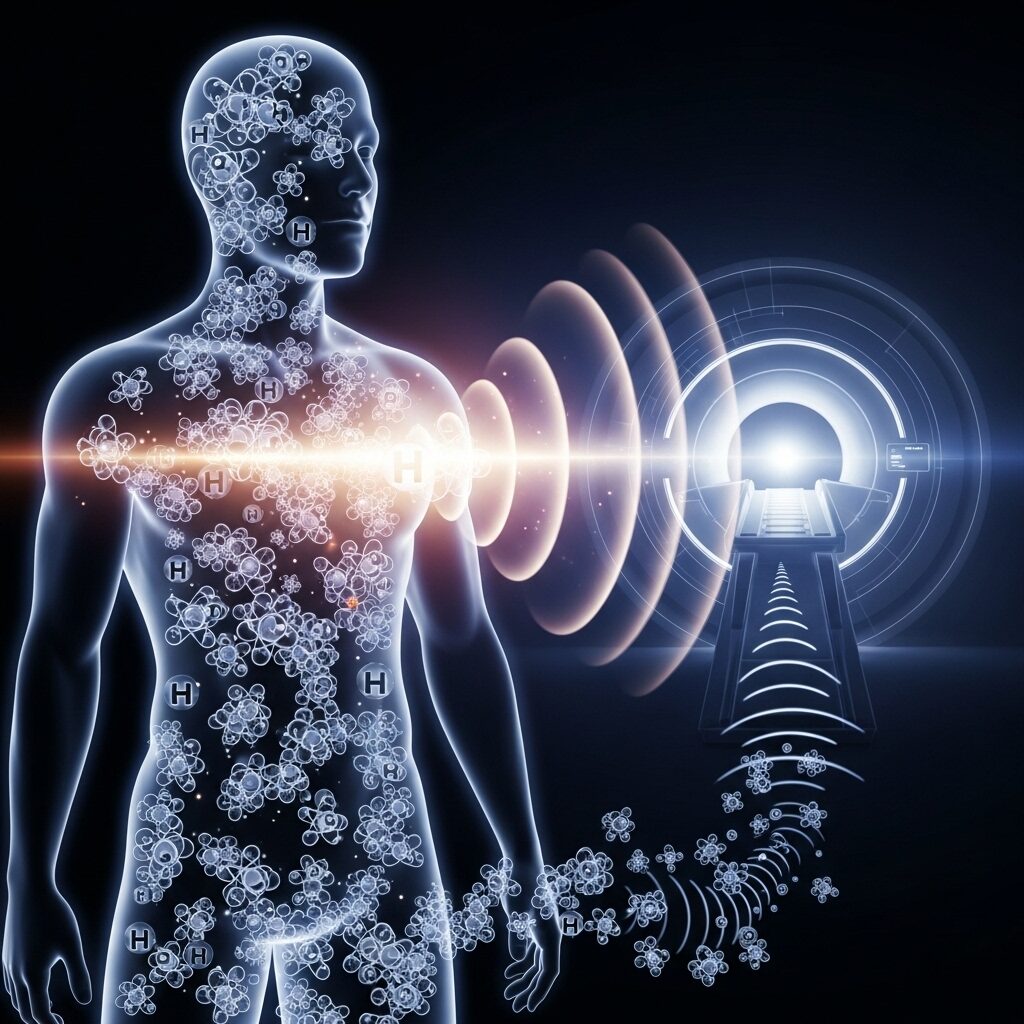
Once hydrogen stands at attention, MRI sends a radio-frequency (RF) pulse—a quick “pop!”
Hydrogen tilts, stores energy, and when RF stops, it relaxes back, emitting a tiny echo (signal).
That echo is the raw ingredient of MRI images, picked up by the receiver coils (the system’s “ears”).
Instrument analogy: pluck a guitar string → “beeennn” → an afterglow you can hear. Hydrogen does that in radio-wave terms.
Kid-friendly RF: not music radio—invisible electromagnetic “cue.”
Cue on → “Yup!” (hydrogen tilts). Cue off → tiny echoes on the way back.
Flow so far
- Align (tune the band)
- Pluck with RF (start the performance)
- Record the afterglow (capture the sound)
4) Why black & white? Different “return speeds”
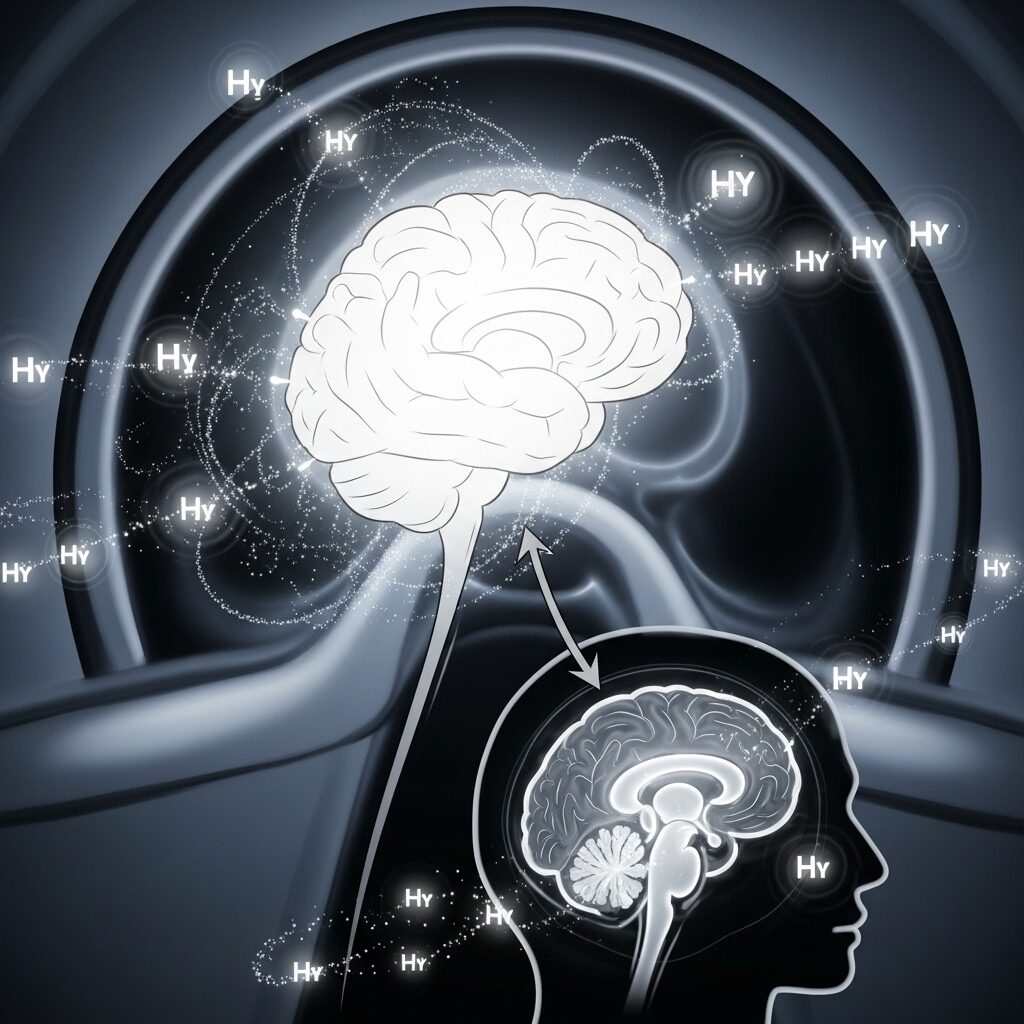
All tissues echo, but they return at different speeds. That difference creates contrast.
- Fast return → brighter (white-ish)
- Slow return → darker (black-ish)
MRI lets you choose what you “listen for” by changing settings—like swapping lenses.
| “Listening mode” | What brightens | What it’s great for |
| T1-weighted | Fat | Anatomy, shape, crisp structure |
| T2-weighted | Water, edema, inflammation | Spotting disease/changes |
| PD (proton density) | Amount of hydrogen | Joints, cartilage detail |
Key points
- Bright ↔ fast return; dark ↔ slow return
- T1/T2/PD = which “instrument” you highlight
5) What’s that “ga-ga-ga!”? The drums of MRI
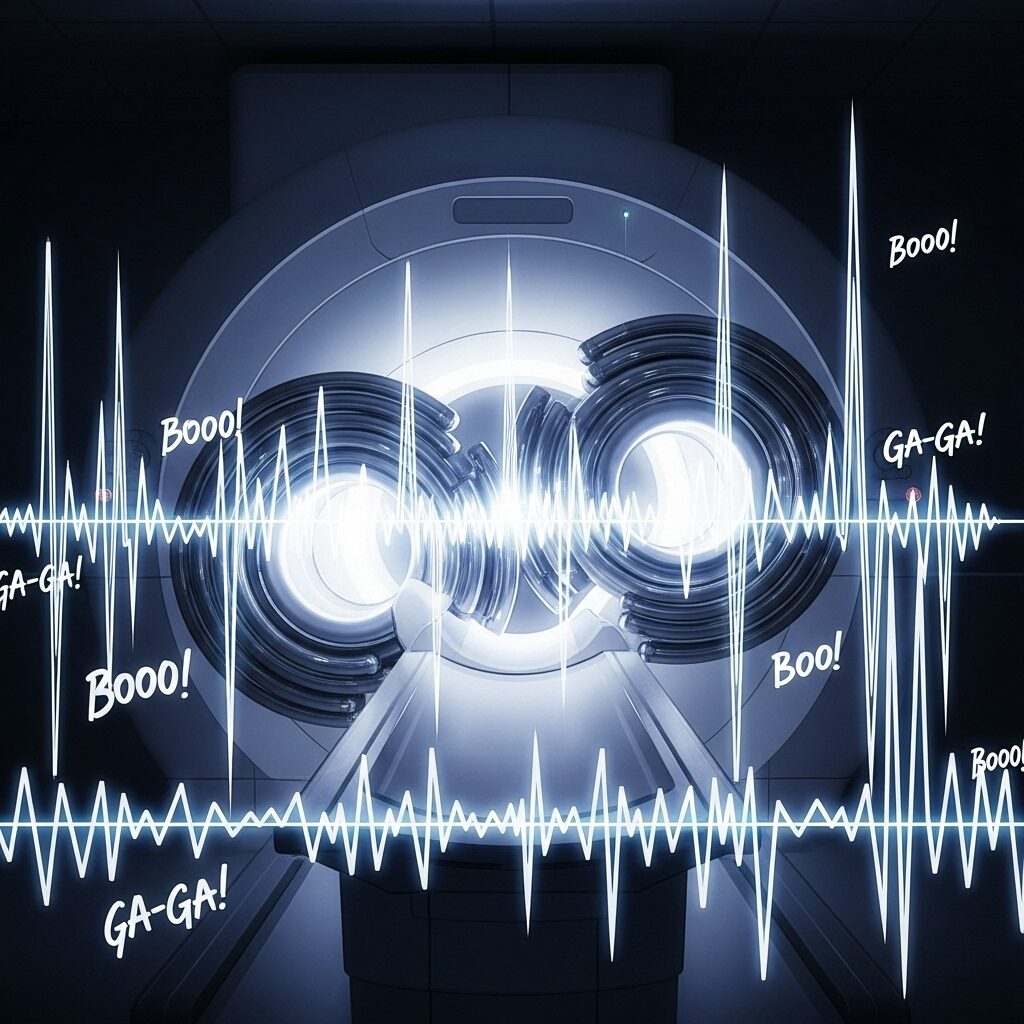
Good news: that loud noise is normal.
What happens
- MRI must label where signals come from. It uses gradient coils to nudge magnetic strength by location.
- Huge currents switch fast → Lorentz forces shake metal bits → vibration turns into sound.
- Think: electricity THUMP → magnet GRAB → coil SHIVER → air BUZZ → your ear goes GA-GA-GA 🤣
Reassurance
- It’s hardware vibrating, not your body.
- Loud ≠ dangerous. It means the gradients are working hard.
Kid-friendly gradient: a graph-paper grid drawn with magnet strength so the scanner knows address labels (“this is head,” “that’s belly”).
Rule of thumb
- MRI noise ≈ 80–110 dB (construction site / subway).
- DWI can be louder.
- Use the earplugs/headphones the facility gives you. Mandatory & safe.
Key points
- Noise is a sign of proper operation, not danger.
- Hearing protection is standard.
6) Why MRI rocks (and where it shines)
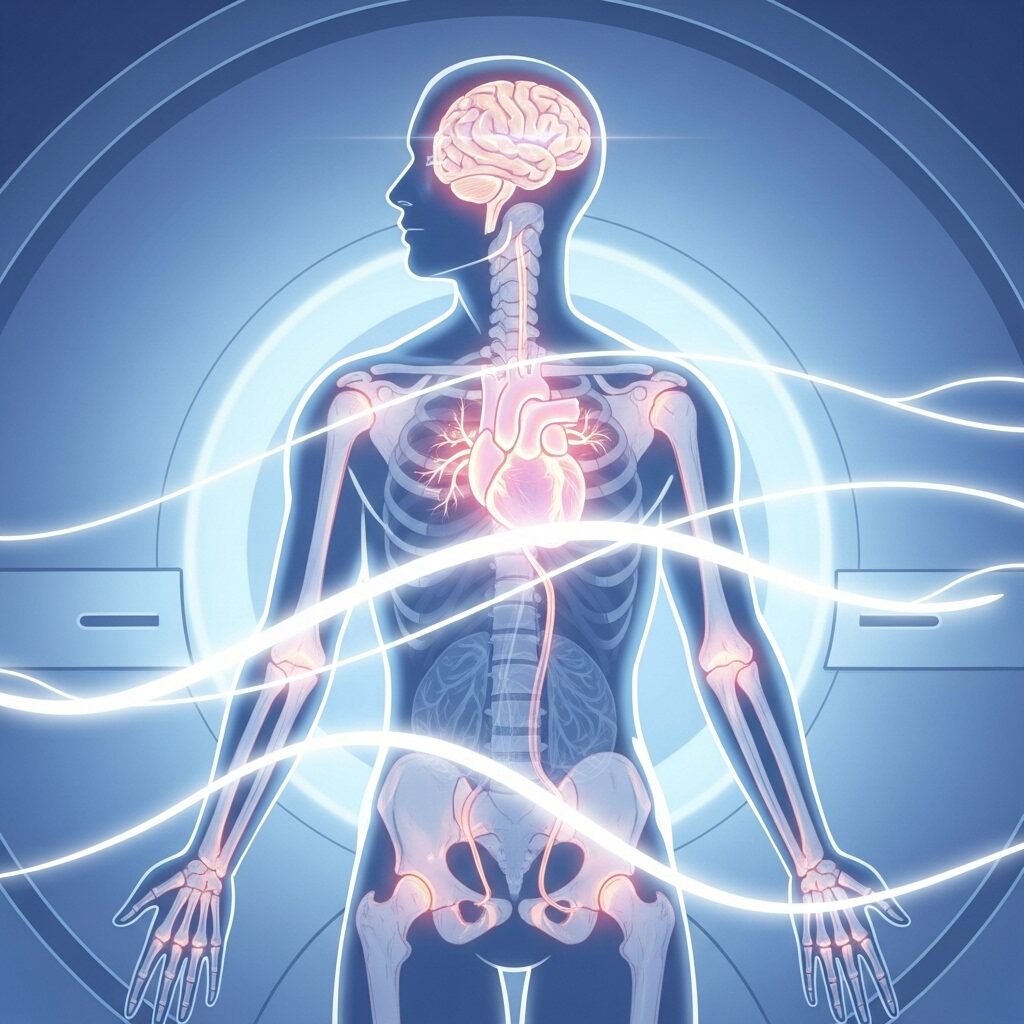
“Loud and slow—sounds annoying?” Hold up. MRI has superpowers others don’t.
- No radiation (zero dose) → peace of mind
- Soft-tissue expert → brain, spinal cord, joints, viscera
- Wildly versatile → blood flow, vessels without contrast (MRA), even fMRI (brain activation)
Audio analogy: X-ray is mono; MRI is hi-res orchestra—it separates the tiniest parts.
Examples
- Brain: early stroke, tumors
- Joints: meniscus & ligament tears
- Vessels: contrast-free MR angiography
- Function: fMRI lights up active brain areas
Cautions (important!)
- No ferromagnetic metal in the room
- Pacemakers, cochlear implants, some clips may be MRI-unsafe
- Claustrophobic? We can help with eye masks, music, faster sequences, or sedation when appropriate
Key points
- Zero radiation
- Soft-tissue champion
- Broad applications
- Metal matters — honest screening is vital
7) Life-or-death rule: What not to bring into MRI
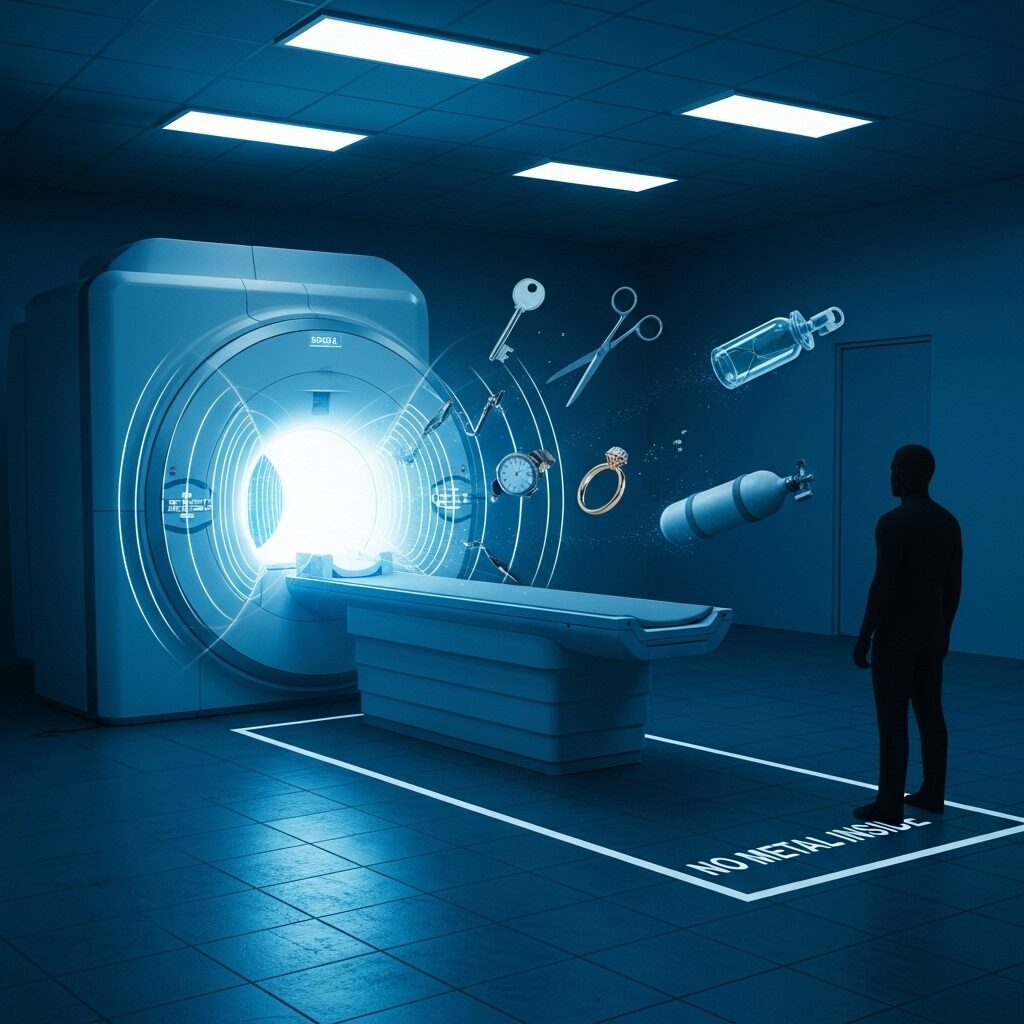
MRI’s magnet can be >30,000× Earth’s field. Certain items are absolutely off-limits.
Often NOT allowed for scanning
- Pacemakers, cochlear implants, some aneurysm clips
→ Devices can fail or move. Declare them.
Never bring/wear into the room
- Jewelry (rings, necklaces, piercings)
- Watches (including smartwatches)
- Heat packs / patches, magnetized plasters
- Some makeup with metallic pigments
Easy image: the MRI room is a giant vacuum cleaner for iron—it will yank metallic stuff in a flash. Real incidents have involved flying oxygen tanks and clipboards.
Key points
- Certain implants = scan may be prohibited
- Accessories/heated patches = burn/accident risk
- Honest disclosure = safety
8) Exam-day pro tips for a smooth, fast MRI
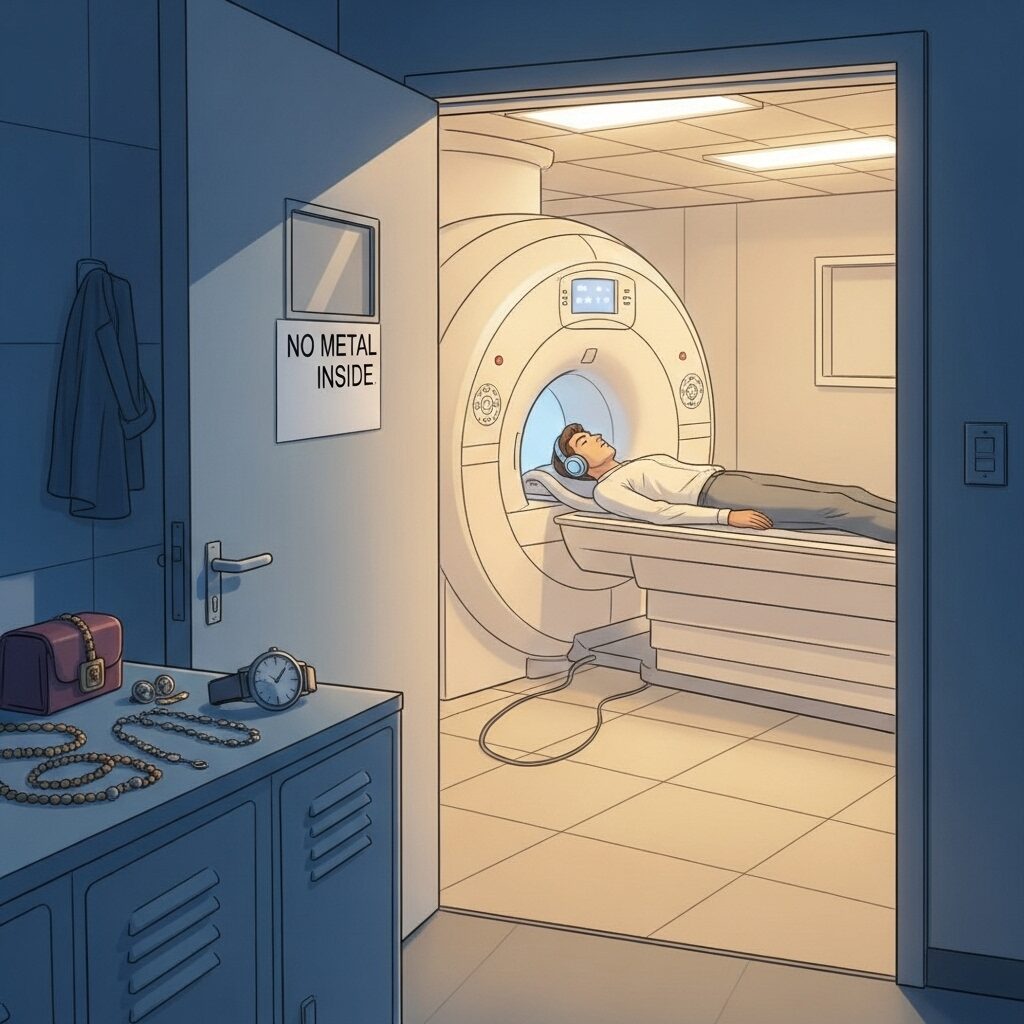
MRI is simple when you relax and cooperate a little.
- Remove metal
Everything. Rings, watches, patches, etc.
→ Pull, heat, burn risks and image artifacts - Wear simple clothes
No zippers/hooks if possible (or change into scrubs)
→ Metal causes noise on images (might force a retake) - Use ear protection
Earplugs/headphones are required
→ Noise is 90–110 dB; many folks nap through it - Learn the signals
You’ll have a call button and an intercom
→ You’re never “trapped”; staff can talk anytime - Breathe and go limp
Motion blurs pictures; calm stillness = faster, cleaner scan - Answer the screening honestly
Surgeries, implants, tattoos, pregnancy possibilities
→ Direct link to safety
Music-hall analogy: quiet audience ⇒ better recording. Your stillness = cleaner images.
Key points
- No metal
- Simple outfit
- Ear protection
- Know the call button
- Relaxed stillness
9) The 3-step MRI you’ll never forget

Memorize this and you basically “get” MRI:
- Line up — a steady magnet (B0) aligns hydrogen
(Conductor cues: everyone sits tall) - Pluck — RF pulse tilts hydrogen and starts the afterglow
(Pluck the string → “beeennn”) - Sort & map — gradients tag where signals come from; different return speeds draw the black-and-white map
(Percussion keeps time so the score is written correctly)
Today’s takeaways
- Black/white = different relaxation speeds
- “Ga-ga-ga!” = normal drumwork (use ear protection)
- Metal is a no-go; honest screening protects you
Musical wrap-up: MRI is the Great Hydrogen Orchestra.
The conductor (magnet + RF) gives cues, hydrogen plays shimmering echoes, drums (gradients) mark the beat, and the system records it into a score (image).
Loud just means the band is really cooking—no need to fear the sound.
To my fellow 50-somethings
“Loud, long, and a bit scary?” I hear you. But MRI avoids radiation and gives hi-res looks at brain, organs, and joints. It’s a guardian for your future.
Final note
Next time, put in your earplugs and enjoy the “live show.”
Knowing the mechanism halves the fear and doubles the trust. (And give your tech a smile on the way out 👍)
Related Articles You May Enjoy
- A 50-Year-Old Man’s Journey: No More Fear! Easier Prep with Colon CT
👉 A beginner-friendly explanation of Colon CT, showing how it differs from MRI.- 【50s Men’s Health】A New Era in Checkups: PCCT for “Low Radiation × High Precision”
👉 Introducing the latest CT technology—perfect for comparison with MRI.- 🦷 A 50s Man’s Challenge with Dental Implants (Part 1)
👉 A candid story of facing medical fears—great for readers anxious about tests.
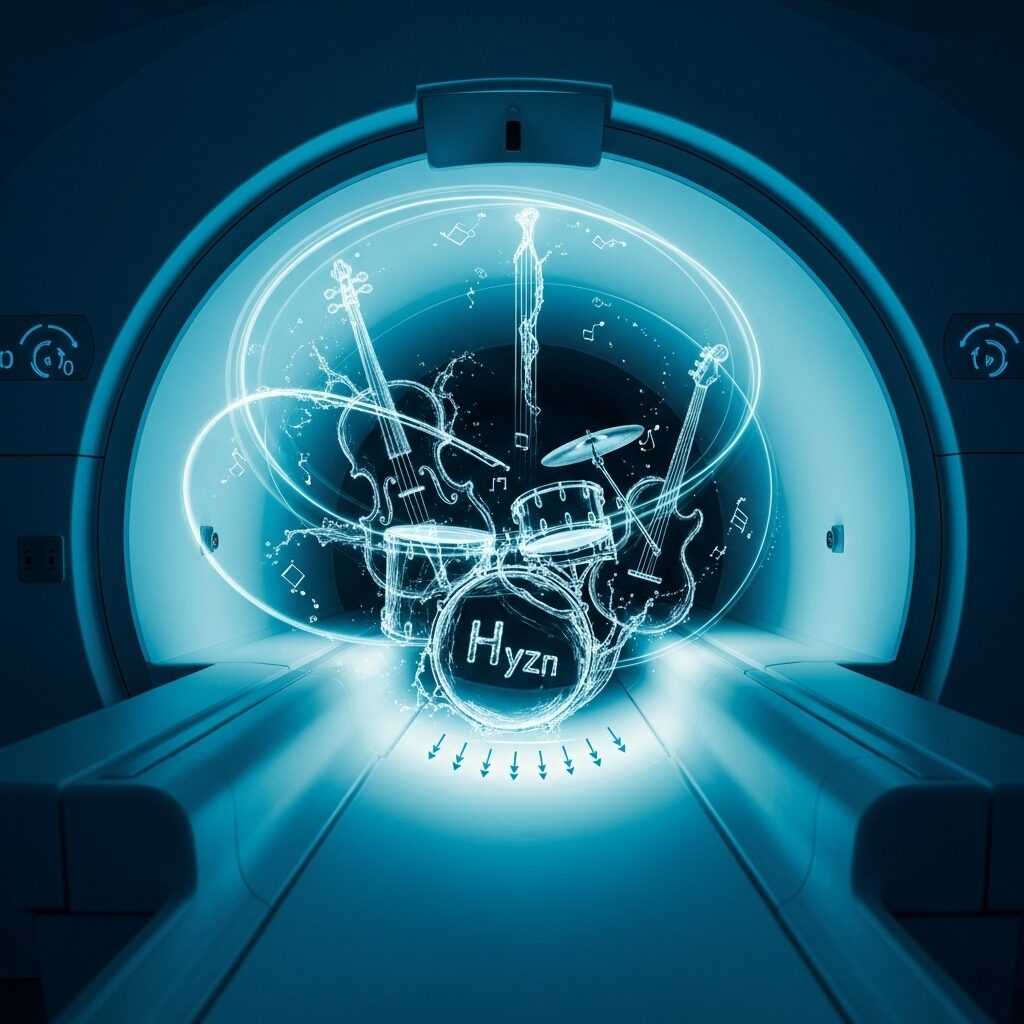


コメント